HDU 5444 Elven Postman(链表实现二叉搜索树)——2015 ACM/ICPC Asia Regional Changchun Online
来源:互联网 发布:apriori算法 置信度 编辑:程序博客网 时间:2024/06/05 05:38
Elven Postman
Time Limit: 1500/1000 MS (Java/Others) Memory Limit: 131072/131072 K (Java/Others)
Problem Description
Elves are very peculiar creatures. As we all know, they can live for a very long time and their magical prowess are not something to be taken lightly. Also, they live on trees. However, there is something about them you may not know. Although delivering stuffs through magical teleportation is extremely convenient (much like emails). They still sometimes prefer other more “traditional” methods.
So, as a elven postman, it is crucial to understand how to deliver the mail to the correct room of the tree. The elven tree always branches into no more than two paths upon intersection, either in the east direction or the west. It coincidentally looks awfully like a binary tree we human computer scientist know. Not only that, when numbering the rooms, they always number the room number from the east-most position to the west. For rooms in the east are usually more preferable and more expensive due to they having the privilege to see the sunrise, which matters a lot in elven culture.
Anyways, the elves usually wrote down all the rooms in a sequence at the root of the tree so that the postman may know how to deliver the mail. The sequence is written as follows, it will go straight to visit the east-most room and write down every room it encountered along the way. After the first room is reached, it will then go to the next unvisited east-most room, writing down every unvisited room on the way as well until all rooms are visited.
Your task is to determine how to reach a certain room given the sequence written on the root.
For instance, the sequence 2, 1, 4, 3 would be written on the root of the following tree.

So, as a elven postman, it is crucial to understand how to deliver the mail to the correct room of the tree. The elven tree always branches into no more than two paths upon intersection, either in the east direction or the west. It coincidentally looks awfully like a binary tree we human computer scientist know. Not only that, when numbering the rooms, they always number the room number from the east-most position to the west. For rooms in the east are usually more preferable and more expensive due to they having the privilege to see the sunrise, which matters a lot in elven culture.
Anyways, the elves usually wrote down all the rooms in a sequence at the root of the tree so that the postman may know how to deliver the mail. The sequence is written as follows, it will go straight to visit the east-most room and write down every room it encountered along the way. After the first room is reached, it will then go to the next unvisited east-most room, writing down every unvisited room on the way as well until all rooms are visited.
Your task is to determine how to reach a certain room given the sequence written on the root.
For instance, the sequence 2, 1, 4, 3 would be written on the root of the following tree.

Input
First you are given an integer T(T≤10) indicating the number of test cases.
For each test case, there is a numbern(n≤1000) on a line representing the number of rooms in this tree. n integers representing the sequence written at the root follow, respectively a1,...,an where a1,...,an∈{1,...,n} .
On the next line, there is a numberq representing the number of mails to be sent. After that, there will be q integers x1,...,xq indicating the destination room number of each mail.
For each test case, there is a number
On the next line, there is a number
Output
For each query, output a sequence of move (E or W ) the postman needs to make to deliver the mail. For that E means that the postman should move up the eastern branch and W the western one. If the destination is on the root, just output a blank line would suffice.
Note that for simplicity, we assume the postman always starts from the root regardless of the room he had just visited.
Note that for simplicity, we assume the postman always starts from the root regardless of the room he had just visited.
Sample Input
242 1 4 331 2 366 5 4 3 2 111
Sample Output
EWEEEEEE
Source
2015 ACM/ICPC Asia Regional Changchun Online
解题思路:这题题目比较长,就不按题目来解释了,此题说白了就是让你按给定的序列建一棵二叉搜索树,如序列2,1,4,3,可以得到这么一棵二叉搜索树

这样的话,2就是树的根,然后q次询问,每次要求输出从树根如何到xi
比如说xi=1时,即2如何到达1,那只需往E走
而xi=3时,从2到3则需先往W走,再往E走,所以输出WE
而样例2的话,6,5,4,3,2,1是这样一棵树

所以从树根6到1要一直往E走,故输出EEEEE
#include<stdio.h>#include<queue>#include<algorithm>#include<string.h>using namespace std;struct tree{ int data; struct tree *left; struct tree *right;};typedef struct tree treenode;typedef treenode *btree; /* 往链表二叉树插入数据*/btree insertnode(btree root, int val){ btree newnode; btree current; btree backnode; newnode = (btree)malloc(sizeof(treenode)); newnode->data = val; newnode->right = NULL; newnode->left = NULL; if(root == NULL) return newnode; else { current = root; while(current != NULL) { backnode = current; if(val > current->data) current = current->right; else current = current->left; } if(backnode->data > val) backnode->left = newnode; else backnode->right = newnode; } return root;} //创建链表的二叉树btree create_sbtree(int *data, int len){ int i; btree root = NULL; for(i=0;i<len;i++) root = insertnode(root,data[i]); return root;} void printbtree(btree root,int x){ btree ptr; ptr=root;//printf("%d\n",ptr->right->data); while(x!=ptr->data&&ptr!=NULL) { if(x==ptr->data) break; if(x<ptr->data) { ptr = ptr->left;//printf("%d %d\n",x,ptr->data); printf("E");//puts("*");return ; } else { //printf("%d %d\n",x,ptr->data); ptr = ptr->right; printf("W"); } } puts("");}int s[1005];int main(){ int t,n,i,q,x; scanf("%d",&t); while(t--) { btree root = NULL; scanf("%d",&n); for(i=0;i<n;i++) scanf("%d",&s[i]); root =create_sbtree(s,n); scanf("%d",&q); for(i=0;i<q;i++) { scanf("%d",&x); printbtree(root,x); } } return 0;}菜鸟成长记 0 0
- HDU 5444 Elven Postman(链表实现二叉搜索树)——2015 ACM/ICPC Asia Regional Changchun Online
- hdu 5444 Elven Postman 树的先序遍历 2015 ACM/ICPC Asia Regional Changchun Online
- HDU 5444.Elven Postman【2015 ACM/ICPC Asia Regional Changchun Online】【二叉树建立与遍历】9月14
- HDU 5444 Elven Postman (2015 ACM/ICPC Asia Regional Changchun Online)
- hdu 5444 Elven Postman 2015 ACM/ICPC Asia Regional Changchun Online
- HDU 5444Elven Postman 2015 ACM/ICPC Asia Regional Changchun Online
- HDU 5438 Ponds(dfs)——2015 ACM/ICPC Asia Regional Changchun Online
- 2015 ACM/ICPC Asia Regional Changchun Online hdu 5438
- hdu 5438 Ponds 2015 ACM/ICPC Asia Regional Changchun Online
- HDU 5441 Travel(2015 ACM/ICPC Asia Regional Changchun Online)
- 2015 ACM/ICPC Asia Regional Changchun Online
- 2015 ACM/ICPC Asia Regional Changchun Online
- Regional Changchun Online--Elven Postman(裸排序二叉树)
- 2015 ACM/ICPC Asia Regional Changchun Online 1007 hdu 5443 线段树区间最值
- HDU 5437 Alisha’s Party(优先队列+模拟)——2015 ACM/ICPC Asia Regional Changchun Online
- HDU 5443 The Water Problem(水题 找区间最大值)——2015 ACM/ICPC Asia Regional Changchun Online
- HDU 5441 Travel(离线 + 带权并查集)——2015 ACM/ICPC Asia Regional Changchun Online
- HDU 5446 Unknown Treasure(lucas定理+中国剩余定理)——2015 ACM/ICPC Asia Regional Changchun Online
- python的with语句
- java算法系列之一:堆排序算法
- 日期类
- 快速汉字转拼音
- Android中的动画资源
- HDU 5444 Elven Postman(链表实现二叉搜索树)——2015 ACM/ICPC Asia Regional Changchun Online
- Myeclipse+mysql出现中文乱码情况
- js创建对象的几个常用方式
- java__集合03
- 第2周项目3体验复杂度
- ajax post demo
- ACM动态规划之最少钱币问题
- 使用Calendar类得到一年中的二月有多少天
- String类


